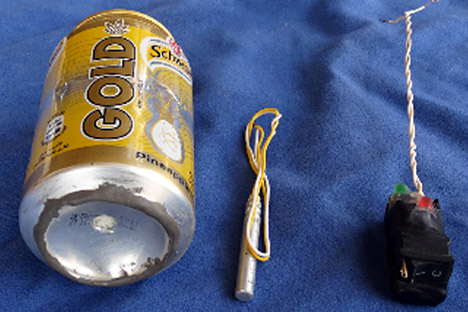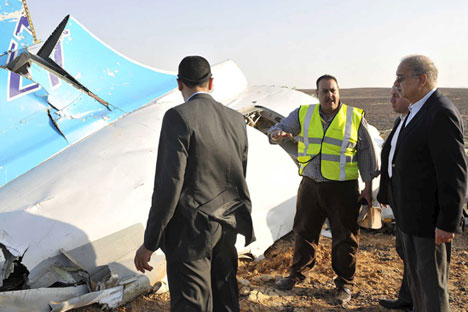Press Digest: Russian experts analyze photo of ISIS ‘Egypt bomb’

The Islamic State terrorist organization (ISIS) claims the bomb in the photograph is the one placed on board the Russian passenger airliner that was brought down over Egypt’s Sinai Peninsula on Oct. 31.
AP‘This type of bomb can be detected only by dogs’
News website Gazeta.ru has asked experts to assess the accuracy of the photo of the bomb allegedly detonated on board the Russian passenger airliner brought down over Egypt’s Sinai Peninsula on Oct. 31.
The Islamic State terrorist organization (ISIS) has published a photo of the bomb, which was allegedly a soft drink can loaded with explosives.
"The photo captures an absolutely real explosive device that was able to cause such a powerful explosion," said Ex-director of the Research Institute of the Russian Defense Ministry, Major General Viktor Poplavsky, according to whom the can contained about 300 grams of explosives.
"The explosive itself, which has a certain smell and other characteristics, can be detected only by dogs," said Poplavsky.
Recently, the Federal Security Service (FSB) confirmed the terrorist attack aboard the crashed airliner. On Tuesday, FSB head Alexander Bortnikov said that the study of personal effects and aircraft components, as well as expert analysis, had detected traces of explosives.
"According to the estimates of our experts, a homemade bomb containing up to one kilogram of TNT detonated on board the Airbus A321 during the flight, causing the plane to break up in midair, which explains why parts of the fuselage were spread over such a large area," said.
World Anti-Doping Agency (WADA) suspends RUSADA for non-compliance
At a meeting in Colorado, all 38 members of the World Anti-Doping Agency (WADA) Foundation Board unanimously supported the committee's decision to deem the Russian anti-doping agency (RUSADA) non-compliant with its code, reports business daily Kommersant.
Now, representatives of WADA, as reported by its president Craig Reedie, are intending to meet with the Russian authorities to discuss the decision taken by the agency. According to an adviser to the Minister of Sports of Russia on anti-doping issues, Natalya Zhelanova, who participated in the meeting, WADA will also prepare a list of measures to eliminate the violations in RUSADA's activities.
The national anti-doping agencies of Andorra, Israel, Argentina, Bolivia and Ukraine were also deemed non-compliant and deprived of international certification by WADA.
WADA's official website reported the decision of WADA Foundation Board to establish – in cooperation with the International Olympic Committee (IOC) – an independent anti-doping group of experts.
The list of the group's powers and the exact composition of its members will be approved at the next WADA Foundation Board meeting in May 2016.
Russia uses secret new rocket in Syria
The Russian air force has used the latest X-101 cruise missile against terrorist targets in Syria, reports the Rossiyskaya Gazeta daily, citing the Oruzhiye Rossii (Weapons of Russia) news agency.
The missile, which had not previously been used, was seen in a video of a strike by strategic bombers at militant positions released by the Russian Defense Ministry.
The X-101 has a much longer range than its predecessor, the X-55 – by the most conservative estimates, it can fly 3,400 miles (5,500 kilometers), wrote Dave Majumdar, defense editor of The National Interest.
At the same time, the missile is stealthy and accurate – it uses a combined system of navigation: inertial and GLONASS – and is capable of hitting its target with a deviation of no more than five meters.
Earlier, mass-dimensional models of the new weapon were spotted on the underwing pylons of the Tu-95, but the missile used in Syria differs from the prototype – apparently as a result of improvements.
According to open sources, the weight of the X-101's warhead is 880 pounds (400 kilograms). The missile also has a nuclear version, the X-102, with a 250-kiloton warhead. In addition to the type of charge, the X-102 differs in its technical and tactical characteristics.
Read more: Russian armed forces destroy 14 ISIS sites
All rights reserved by Rossiyskaya Gazeta.
Subscribe
to our newsletter!
Get the week's best stories straight to your inbox

